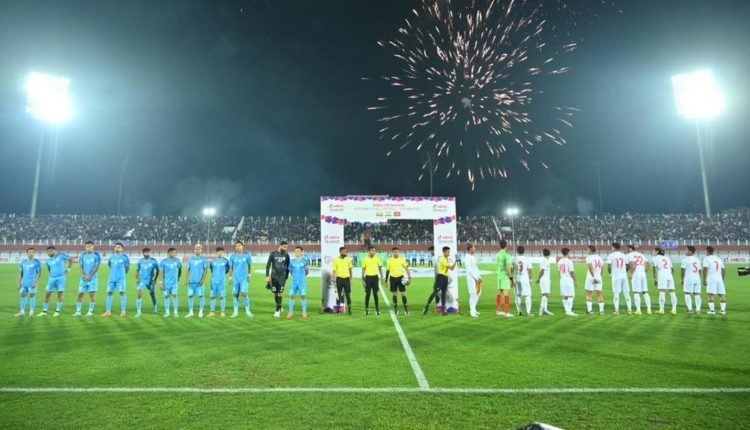In early May, Hindustan Times published a story by football writer Dhiman Sarkar that should have triggered nationwide dismay and triggered a response. The houses and property of two India international footballers were vandalised, looted, torched and destroyed. Their families had to flee into Army camps. In one case, the footballer escaped along with them, in the other, the player was rushing back to REACH his loved ones. Except this was Manipur, the two footballers Chinglesana Singh and Thongkosiem ‘Semboi’ Haokip are not pan-national celebrities and so the news vanished.
“If these things happened in any other state, in a bigger state, this would be news every time, every minute. Because it is in the northeast and because it is in Manipur…” This is Renedy Singh, ex-pro footballer, former India captain, now coach talking not just about Sana and Semboi but about the terrifying ethnic violence, killings and fear that have spread through his state for an entire month.
Football may be the last thing on anyone’s mind, but the ethnic clashes has broken down the state’s expanding talent-generation network. Historian-statistician Gautam Roy confirms that ISL 2022-23’s state-wise player breakdown had Manipur on top with 37 players, followed by Bengal (34) and Mizoram (31) with Goa, Punjab and Kerala (27 each). In the I-League ‘22-23, Manipur was the only state that fielded two clubs – NEROCA and Trau FC.
All through spring, youth football teams in Manipur’s valley and hill districts were moving into their new season plans. Renedy’s Classic Football Academy in Imphal (the Renedy Football School being renamed after a collaboration with NEROCA owners Classic Group) were India U-17 champions, winning the Hero Youth Cup. Their U-20s were giving local teams a scare. They had qualified for the Manipur Premier League and the next step was to push for an I-League second division spot.
Less than 40km north in Saikul, Kangkokpi district, the Football 4 Change Academy (F4CA) was preparing for Manipur’s all-comers knockout tournament, the 73-year-old Churachand Singh Trophy. F4CA founder-schoolteachers Hegin Len and David Suantak were putting together paperwork to apply for accreditation for the AIFF Youth Leagues.
When the riots scorched the state on May 3, violence and rumour spread faster than the wind. The internet was shut down and has not resumed since. Classic is not a residential academy but many of its multi-ethnic students – from age 13 to 21 – from out of town rushed back home.
F4CA is housed in Saikul’s SNGC High School, with boarding for its 130 students. As rioters swept through parts of the valley and headed for the hill districts, the terror-whispers moved faster than them. That the mobs were coming, Meiteis to kill destroy Kuki villages, Kukis to destroy Meitei settlements, ‘ethnic cleansing’ ‘genocide’. F4CA’s football school emptied out with coaches and half of its students finding safe passage home; the rest, 60 boys between 9 and 18, were left under Len and Suantak’s care. They had to be kept safe, fed and busy. Rice was going at ₹1800 a bag and there appeared to be no help from the outside.
The boys were moved away from their boarding into the school building itself, a good, protected distance away from the prospect of madness on the main road. At night, older boys took turns and kept vigil with Len and Suantak. It has been weeks of tension.
While growing up as teenagers, Renedy and Suantak had only heard stories about ethnic troubles and riots in Manipur. To see the state go into a death spiral of ethnic hatred has shaken them. “As a footballing person,” Renedy says, “I am angry and upset. I’ve played with… my teams have had Kukis, Nagas, Meiteis – and we fight for one thing. That is to win together. Now it is like there is fighting in the family. Who do you support?”
Given that footballers’ lifespan runs on a clock, neither academy head wants their careers to stagnate. Renedy is thinking of loaning out his players to other academies for a year, “so their football doesn’t stop.” F4CA has resumed training but “it is not very effective the boys are quiet.” Len and Suantak are going to travel by road to Kohima to find a working net connection and to email their accreditation application to the AIFF. And buy vegetables to feed the kids. Suantak says, “Hegin and I will go on, we will find a way, I know that I worry about smaller academies – things were just being just being built and now it’s we have gone back five-six years.” The All Manipur Football Association has been in touch with academies like F4CA, with talks about a unity match – some time in a future of greater sanity and calm.
Renedy says, “Football will come last… our so-called big leaders should react, come together and solve the problem so that we can live a normal life like the rest of India.” Suantak shrugs because he believes that football people “have no power.”
Except all over the burning rubble of Manipur football, irony walks around on two legs. Biren Singh, the chief minister of Manipur played football for the BSF. Kalyan Chaubey, the newly-elected head of the All India Football Federation (AIFF), kept goal for Mohun Bagan, East Bengal and India. The AIFF chose to make no statement about the horrors that broke over Sana and Semboi. There is word that they are directly in touch with affected players extending best possible help and support.
Yet, an official word from the very top, that the Indian footballing community stands with their Manipuri family, would have meant much more. It would have sent the single most important message from Indian football, of solidarity and team: that no matter what, we are one.


